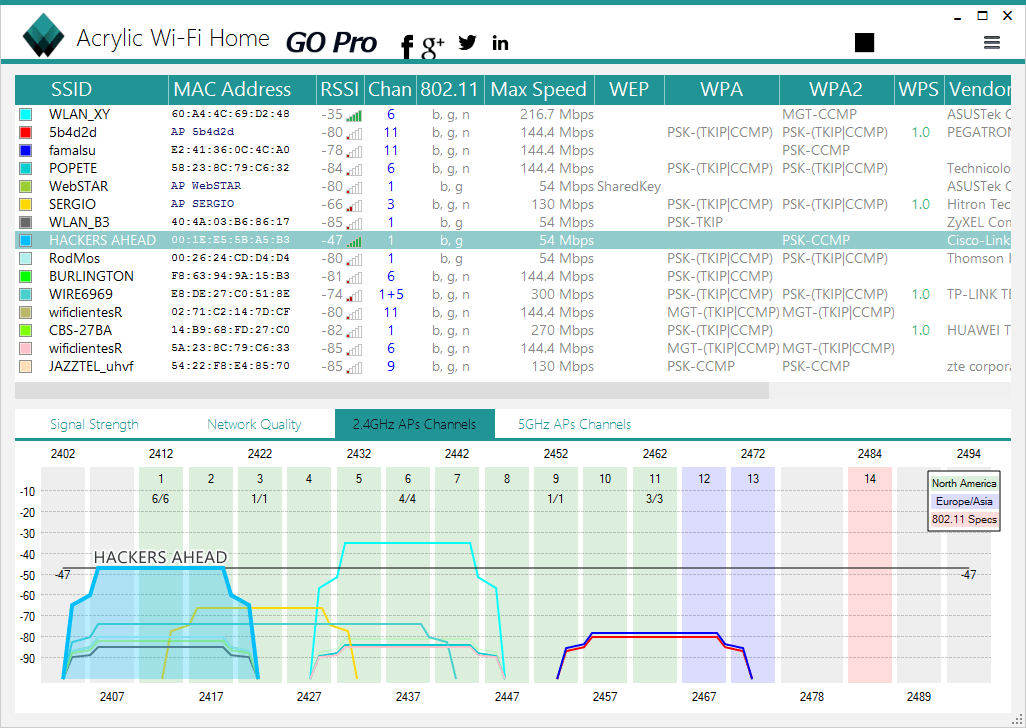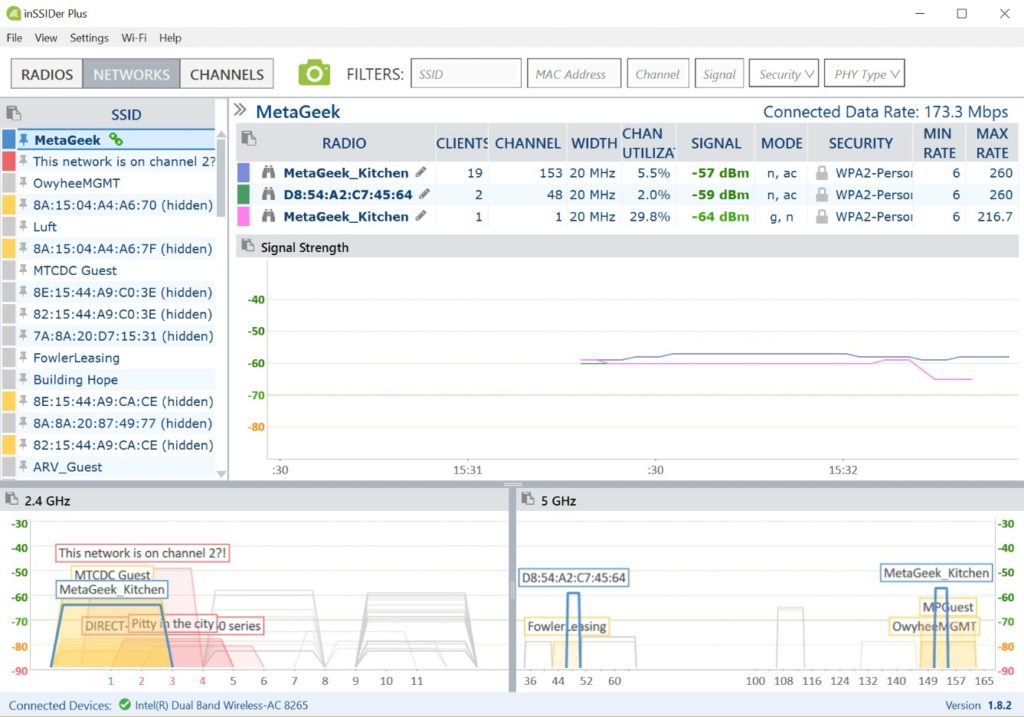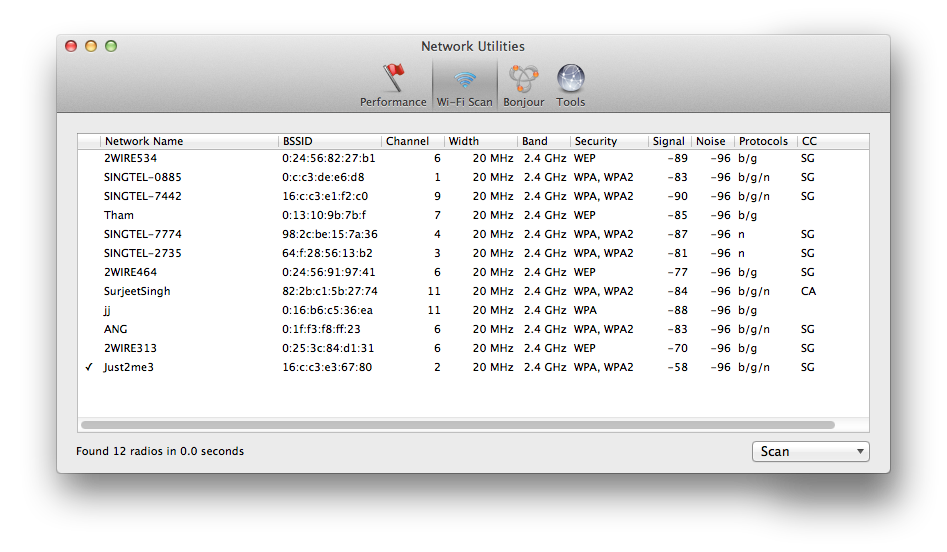Wifi Scanner For Mac
A WiFi network introduces a variety of issues that can negatively impact your ability to connect and stay connected. These factors can also lead to network speed and security concerns that you will not face with a wired connection. Here are some of the configuration and installation concerns that you may experience when you employ a WiFi network.
- WiFi router location – Where you place your WiFi router can have a tremendous impact on the ability of your wireless network to serve all of its intended users. You need to strive for a centralized location that is free from physical obstructions which can affect the reach of the WiFi signal. Incorrect placement will lead to a proliferation of dead spots where your devices cannot connect to the network.
- Security – You need to ensure that your WiFI network is protected by at least WPA2 level encryption and a strong password, preferably one of at least twelve characters. This will minimize the possibility of your network falling victim to a brute force attack that can compromise your password and allow unauthorized access.
- Slow and dropped connections – This is one of the most common issues with WiFi networks. It can often be traced to overuse of specific WiFI channels. Modifying the channel that your router uses can greatly reduce or eliminate these types of problems. Use of a WiFi scanner is a great way to monitor and analyze your current WiFi channel usage and make informed decisions that can drastically improve the utility of your network.
Wifi Scanner App For Mac
What Exactly is a WiFi Channel?
Use WiFi Scanner for all of your network troubleshooting needs. This desktop app includes 2.4 GHz and 5 GHz channel graphs, data rates, security information, and more. Learn About WiFi Scanner for Mac OS. Learn About WiFi Scanner for Windows. Fujitsu PA03688-B005 ScanSnap iX100 Wireless Mobile Scanner for Mac and PC,Black 4.2 out of 5 stars 390. Fujitsu SCANSNAP S1100i MOBILE SCANNER PC/MAC 4.4 out of 5 stars 329. Fujitsu ScanSnap S1300i Instant PDF Multi Sheet-Fed Scanner Trade.
WiFi routers can use two different frequency bands to produce their signal: 2.4GHz or 5GHz. Some routers are dual-band and can deliver their signal using whichever frequency you choose to employ. Each frequency contains a number of smaller frequency bands used for signal transmission. These smaller bands are referred to as WiFi channels.
There are differences in how the two frequencies perform when providing their signal to connected devices, according to lifewire.com. These differences may impact which type of router is best for your particular situation. Let’s take a quick look at what makes each frequency distinctive.
WiFi Scanner is a free 802.11 wireless scanner and connection manager for Mac OS X 10.6 Snow Leopard or later. This will detect access points and clients in ad-hoc mode if the SSID is being. Before setting up your scanner, make sure macOS has the latest scanner software available to it. The Best WiFi Channel Scanners for macOS. Here are some other WiFi channel scanners that you can run on your macOS system. NetSpot is a full-featured WiFi tool that runs on the Mac and Windows platforms. You can conduct surveys on your own and nearby wireless networks in order to ascertain the channels that are overloaded.
2.4 GHz frequency

Slower data transmission speed.
Larger network coverage area due to extended range.
More susceptible to interference from other household devices that use the same frequency.
The number of available channels is 11.
5GHz frequency
Greater data transmission speed.

Reduced network coverage area due to a shorter range and an inability to penetrate solid objects.
Less interference as not many other devices use the 5GHz frequency band.
The number of available channels is 45.
Why do Certain Channels Incur More Interference?
The reason that certain WiFi channels may offer better performance for your connected devices is related to the interference that a particular channel may be experiencing. Interference in the work of WiFi channels comes in two flavors.
Co-channel interference – This type of interference, also known as crowding, occurs when a number of devices are competing for bandwidth on the same channel. This can cause slower than expected data transmission and dropped connections.
Adjacent-channel interference – When devices from overlapping channels are attempting to talk over each other, adjacent-channel interference can occur. The bandwidth and number of channels associated with 2.4GHz routers make these devices susceptible to this type of interference.
Why You Should Use a WiFi Channel Scanner
If you are experiencing slow data transmission speeds or dropped connections, a likely cause is interference that is impacting the channel that your router is using. Through the use of a WiFi channel scanner app, you can monitor the channels that you and neighboring routers are using and perhaps change channels.
Many users never change their router channel, leaving it at the manufacturer’s default setting. This may not be the best channel for optimal performance of your WiFi network. Logging into your router lets you change the channel that it will use to transmit its signal. Changing it randomly may solve your issues, but you are far more likely to succeed with the information gleaned from scanning the channels.
In areas where there are a number of routers with overlapping ranges, moving to an unused channel can dramatically improve the reliability and speed of your WiFi network. Apartment dwellers are particularly prone to having their networks impacted by other routers. Let’s find out how to use a WiFi scanner app to locate the best channel for you to use.
Best Home Wifi Scanner For Mac
Using KisMAC to Scan Your WiFi Channels
KisMAC is an open-source, freeware WiFi channel scanning tool that can help you tune your router and find the appropriate channel for your network. It is designed for the Mac and is designed for use by experienced network security professionals. The tool has powerful capabilities beyond that of channel scanning, and its use is prohibited in some European countries.
You may need to use an additional network card as KisMAC does not support some of the cards installed on newer Macs. Once you have KisMAC up and running, initiate a scan of all nearby WiFi networks. Detailed information regarding each network will be displayed in the application’s window, including the channel that the router is using. You can use this information to make an informed decision about which channel you should configure your router to use.

The Best WiFi Channel Scanners for macOS
Here are some other WiFi channel scanners that you can run on your macOS system.
NetSpot
NetSpot is a full-featured WiFi tool that runs on the Mac and Windows platforms. You can conduct surveys on your own and nearby wireless networks in order to ascertain the channels that are overloaded. The app offers a user-friendly interface that makes it easy to scan your WiFi channels and you can save reports in a variety of formats for later analysis. It is available as a free trial download that should be sufficient for channel scanning purposes.

WiFi Scanner
This tool is available at the iTunes App Store and provides all the features that you need to successfully scan WiFi channels in your quest for optimal network performance. Data can be exported to CSV files making future analysis a simple task.
WiFi Signal
Here is another iTunes app that will enable you to scan your WiFi channels as well as display other information about any nearby networks, including your own. It is a simple and inexpensive tool that can easily show you if you are using an overloaded WiFi channel.
Now you know more about WiFI channels and how they can impact your network than the average computer user. Proper use of this knowledge can lead to improved WiFi network performance, and that’s never a bad thing.
Free Wifi Scanner Mac
Related articles:
